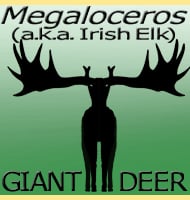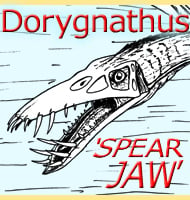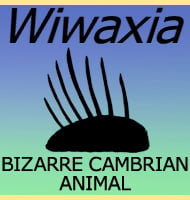The pterosaurs are an extremely diverse group of reptiles that go beyond the generic long beaked lightly built winged lizard image that they are often reduced to in popular culture.
Even a brief look at the group can reveal a surprisingly large amount of variation in groups which can feature extreme variations for different feeding and flying styles.
10 - Tapejara

This is another pterosaur that had an elaborate tall head crest that seems to have been primarily for display purposes.
Crests in pterosaurs have and continued to be studied to see how they affected the flight dynamics of the pterosaur in question, but usually the potential advantages and disadvantages are considered to be secondary to display.
This is because every genus has a different shaped head crest and if the crests were to aid flight the designs would surely become standardised.
Tapejara is but one of a larger group of distinctive pterosaurs that have large laterally compressed (large when viewed from the side but thin from the front) crests combined with a relatively short and deep set of jaws.
The diet of Tapejara has since been the subject of a lot of debate as while most consider it to be a piscivorous fish-eater; some consider the possibility of it and possibly other similar pterosaurs being fruit eating frugivores.
9 - Ornithocheirus
Ornithocheirus has enjoyed a surge in popularity since the end of the twentieth century mainly in part due to possible specimens of very similar pterosaurs discovered in Brazil, as well as a centre stage appearance in the popular BBC series ‘Walking with Dinosaurs’.
However while the latter depiction was as accurate portrayal of its possible lifestyle, the twelve meter wingspan quoted in the show is beyond the scope of any fossil material that has been attributed to this genus.
Instead Ornithocheirus had an upper wingspan of five meters, although the addition of new material may see this size increase to six meters.
Like many other pterosaur genera the fossils of Ornithocheirus are usually in a very poor state of preservation. This problem was heightened in 1869 when the genus was first raised by Harry Govier Seeley who only had fossils that had been badly eroded by sea water.
This problem continues today with poorly preserved and fragmentary remains still being found today in places like South America that seem to resemble earlier specimens of Ornithocheirus, but may in fact turn out to be something very similar but still different.
As a pterosaur, Ornithocheirus represents a type that was very well adapted to catching fish while on the wing.
Hunting behaviour would involve Ornithocheirus flying low over the water and dipping its beak below the surface to snatch a fish out of the water.
All members of the ornithocheirid group have long thin teeth that project outwards to enhance the possibility of prey capture.
Many ornithocheirid pterosaurs also have ‘keels’ on the tips of the snout and lower jaw which were semi-circular crests.
Not only could they have been used for display, but they could have stabilised the beak as it was skimmed through the water.
8 - Quetzalcoatlus

No top ten pterosaur list would be complete without the member that is considered the largest of the group.
However while Quetzalcoatlus is considered the largest, the exact size is a matter of scaling up missing bones by comparison to other pterosaurs, something that has created a degree of variability in size quotations.
Also while Quetzalcoatlus is generally regarded as the largest, others such as Hatzegopteryx are in a position to take this title away from Quetzalcoatlus.
Only a general lack of fossils results makes it hard to ascertain one or the other as an absolute.
The large size of Quetzalcoatlus has made it hard for many to imagine such a large creature as being capable of flight as no living animal is capable of matching Quetzalcoatlus’s size with the ability to fly.
However just because there is no living precedent to prove this, it does not mean that flight for Quetzalcoatlus was impossible.

Quetzalcoatlus is classed as an azhdarchid pterosaur, members known for having very long necks.
Hunting behaviour for Quetzalcoatlus was for a while inferred as being a skim feeder, plucking fish from near the surface of the water, but additional studies have shown that the long neck meant that Quetzalcoatlus was poorly adapted for such a feeding strategy.
Current thinking has Quetzalcoatlus behaving much like a stork while on the ground, using its long neck and beak to pluck up small animals like lizards and mammals from the undergrowth, as well as possibly fish from the side of rivers and lakes.
7 - Pteranodon
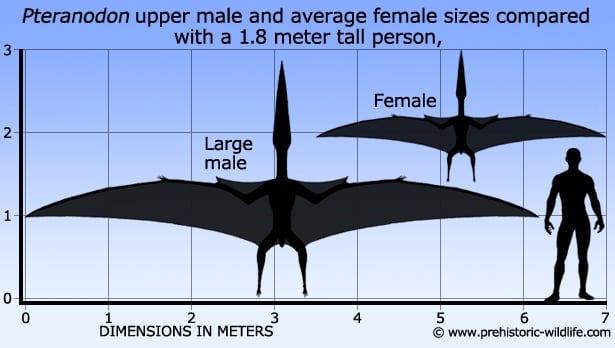
Probably the most instantly recognisable pterosaur due to its inclusion in so many dinosaur books and films, Pteranodon has not been without its share of controversy.
This is mainly centred around the shape and function of the back crest.
Differences between male and females individuals were for a time taken to indicate different species, something that was not helped by the fact that males had crests similar to the females until they reached maturity.
The crest has also occasionally been depicted as supporting a skin sail, although most reconstructions just keep it as a bony projection from the back of the cranium.
The name Pteranodon actually translates to English as ‘toothless beak’, and this makes it very easy to spot inaccurate depictions as Pteranodon is often given teeth to make it look more fearsome.
Pteranodon seems to have been well adapted to life at open sea as its wing structure and proportion is very similar to that of an albatross, and it may have been able to exploit air currents over the surface of the ocean to stay airborne with the minimum of energy expenditure in a similar fashion to the modern bird.
While Pteranodon is often shown to pluck fish from the surface of the water, new interpretations of its skull has led to speculation that it may have dived into the water from a height and actually take fish in its beak while submerged under the water.
This could explain why Pteranodon had a toothless beak as the presence of teeth would have greatly increased drag while under the water.
6 - Dsungaripterus

Another specialist feeder was Dsungaripterus which had a highly adapted beak.
The front portion of this beak was toothless and curved upwards, something that is thought to have been an adaptation for digging out shellfish from soft ground.
Like a crowbar Dsungaripterus could drive this beak into the mud and lever out shellfish that would have buried themselves to survive during the low tide.
The teeth at the back of the mouth were also quite small and not especially sharp.
This made them more robust and effective for crushing thin shells that would have protected shellfish from other predators.
Further evidence for this feeding behaviour also comes from the fact that dsungaripterid pterosaurs are usually found in marine environments.
5 - Pterodaustro

There have been many filter feeding pterosaurs discovered but Pterodaustro is easily one of the most specialised of these.
Instead of just a few teeth arranged in a spoon shape at the end of the jaws like some of the members, Pterodaustro had several hundred teeth that pointed up from the lower jaw that created a fine comb which allowed mouthfuls of water to flow out while small invertebrates were trapped within.
Also many aquatic invertebrates are known to have carotenid pigment that when broken down by the liver turns to a pink/orange, which has led to many palaeontologists recognising the possibility that Pterodaustro may have been a bright pink to deep red in body colour.
This may in part explain why Pterodaustro was nocturnally active as indicated by study of Pterodaustro’s scleral rings, something that would have made it less obvious to potential predators.
4 - Eudimorphodon
With fossils dating back to the Norian stage of the Triassic, Eudimorphodon is one of the earliest pterosaurs to appear in the fossil record.
This tells palaeontologists that while the exact common ancestor to all pterosaurs remains unknown, it must appear in the fossil record before the Norian stage.
This will allow palaeontologists who are searching for this ancestor to focus their search upon deposits that date back to before this age.
As you might expect Eudimorphodon is a very primitive pterosaur, even when compared to rhamphorhynchoid pterosaurs it has the key primitive feature of no stiffening tendons along the caudal vertebra to keep its tail straight.
Eudimorphodon is also a confirmed fish eater as indicated by the presence of fish remains inside its stomach area.
3 - Darwinopterus
Darwinopterus was a major discovery because it has features that are seen in both basal and advanced pterosaurs.
This makes Darwinopterus what is called a transitory form (palaeontologists generally don’t like the term ‘missing link’) that shows the evolution of primitive pterosaurs into their more advanced forms.
Not only is this interesting in itself but the really exciting discovery associated with this is that the pterosaurs do not seem to have evolved their whole bodies at once but instead just evolved certain areas.
This is termed modular evolution and is used to refer to just certain body areas such as the skull, hands, legs, tail, etc. changing while the rest of the body remains the same.
2 - Rhamphorhynchus

Another famous pterosaur, Rhamphorhynchus has been used to name the Rhamphorhynchidae, the group of basal (sometimes called ‘primitive’) pterosaurs.
This means that Rhamphorhynchus had primitive features such as a long tail (that in Rhamphorhynchus was straight with a vane on the end that may have been an inflight steering aid) and short neck vertebrae that connected more to the posterior (back) of the skull like in lizards.
The hands of Rhamphorhynchus are also better suited for holding onto vertical surfaces, an ability that would be reduced in later pterosaurs.
The proportionately long and sharp teeth are thought to have been used to capture small vertebrates such as fish from near the surface of the water.
1 - Pterodactylus
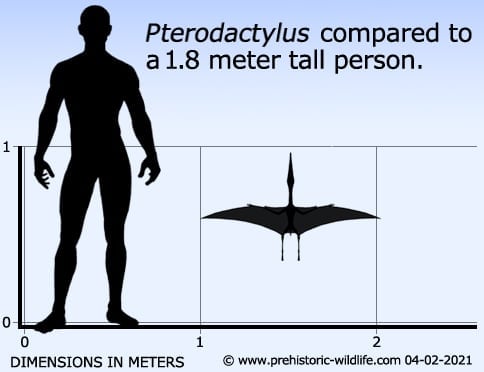
This is the pterosaur that started the science of pterosaur palaeontology as it was the first to be described as one.
However the correct identification was a considerable time coming with some researchers describing it as a bat like creature, and some even thinking that it was an aquatic animal with the wings being used for swimming.
In fact even after the correct identification by Georges Cuvier in 1809 many naturalists still held firm to the earlier ideas.
Pterodactylus has been used to name the group of ‘advanced’ Pterosaurs the Pterodactyloidea.
Although there are many key differences between genera that belong to this group they all share some common features such as short tails, longer neck vertebrae that attach to more underneath the base of the skull rather than the rear, and wings better adapted to flying.
Pterodactylus is also this pterosaur that the more common public name ‘Pterodactyl’ is derived from, a name that has resulted in the general public referring to pterosaurs as ‘pterodactyls’.
The problem with this is that pterodactyl is not recognised by any scientific body as being a valid description of the pterosaurs, or any specific genera.
Honourable Mentions
Sordes

Fossils of this pterosaur have been found with the impression of an extensive covering of pycnofibres, loosely referred to as hairs.
These pycnofibres are not like mammalian hair however and instead are hollow filaments, although they would have served an insulatory purpose like mammalian hair.
Further discoveries such as Jeholopterus also have impressions of pycnofibres, and many pterosaurs are now thought to have had a covering of them, but due to their fragile nature impressions of pycnofibres only preserve when conditions are exactly right.
Anurognathus

This is a good representative of the group of basal pterosaurs that had short but wide mouths. These mouths had long thin teeth that show them to be specialised insectivores, probably taking large flying insects while on the wing.
Nyctosaurus

Very similar to Pteranodon, Nyctosaurus had a greatly enlarged ‘L-shaped’ crest that rose up from the top of its skull. Like with Pteranodon this has been speculated as being the support for a huge skin sail, but modern analysis keeps pointing to the crest just being a bony L structure.



